Exploring Streamwater Mixing Dynamics via Handheld Thermal Infrared Imagery
Abstract
:1. Introduction
2. Materials and Methods
2.1. Study Sites
2.2. Field Measurements
2.3. TIR Image Acquisition
2.4. Data Processing and Analyses
3. Results and Discussion
3.1. Consistency between Temperatures “Sensed” with the TIR Camera and a Submerged Probe
3.2. Inferring Complete Mixing from TIR Stream Observations
3.3. Comparison between Stream EC and Temperature Inferred from Submerged Probe and TIR-Inferred Water Surface Temperature
3.4. Influence of Discharge and Streambed Morphology on Location of the Mixing Front and Mixing Width
4. Conclusions
Acknowledgments
Author Contributions
Conflicts of Interest
References
- Power, M.E.; Dietrich, W.E. Food webs in river networks. Ecol. Res. 2002, 17, 451–471. [Google Scholar] [CrossRef]
- Kiffney, P.M.; Greene, C.M.; Hall, J.E.; Davies, J.R. Tributary streams create spatial discontinuities in habitat, biological productivity, and diversity in mainstem rivers. Can. J. Fish. Aquat. Sci. 2006, 63, 2518–2530. [Google Scholar] [CrossRef]
- Rice, S.; Kiffney, P.; Greene, C.; Pess, G.R. The ecological importance of tributaries and confluences. In River Confluences, Tributaries and the Fluvial Network; Rice, S.P., Roy, A.G., Rhoads, B.L., Eds.; John Wiley & Sons, Ltd.: Chichester, UK, 2008; pp. 209–237. [Google Scholar] [CrossRef]
- Rice, P.S. Tributary connectivity, confluence aggradation and network biodiversity. Geomorphology 2017, 277, 6–16. [Google Scholar] [CrossRef]
- Sanders, T.G.; Adrian, D.D.; Joyce, M.J. Mixing Length for Representative Water Quality Sampling. J. Water Pollut. Control Fed. 1977, 49, 2467–2478. [Google Scholar]
- Sanders, T.G. Representative sampling location criterion for rivers. Water SA 1982, 8, 169–172. [Google Scholar]
- Klaus, J.; McDonnell, J.J. Hydrograph separation using stable isotopes: Review and evaluation. J. Hydrol. 2013, 505, 47–64. [Google Scholar] [CrossRef]
- Hongve, D. A revised procedure for discharge measurement by means of the salt dilution method. Hydrol. Process. 1987, 1, 267–270. [Google Scholar] [CrossRef]
- Kemp, M.J.; Dodds, W.K. Spatial and temporal patterns of nitrogen concentrations in pristine and agriculturally-influenced prairie streams. Biogeochemistry 2001, 53, 125–141. [Google Scholar] [CrossRef]
- Soulsby, C.; Malcolm, I.A.; Youngson, A.F.; Tetzlaff, D.; Gibbins, C.N.; Hannah, D.M. Groundwater-surface water interactions in upland Scottish rivers: Hydrological, hydrochemical and ecological implications. Scott. J. Geol. 2005, 41, 39–49. [Google Scholar] [CrossRef]
- Rademacher, L.K.; Clark, J.F.; Clow, D.W.; Hudson, G.B. Old groundwater influence on stream hydrochemistry and catchment response times in a small Sierra Nevada catchment: Sagehen Creek, California. Water Resour. Res. 2005, 41, W02004. [Google Scholar] [CrossRef]
- Hannah, D.M.; Bruce, W.W.; Nobilis, F. River and stream temperature: Dynamics, processes, models and implications. Hydrol. Process. 2008, 22, 899–901. [Google Scholar] [CrossRef]
- Birkinshaw, S.J.; Webb, B. Flow pathways in the Slapton Wood catchment using temperature as a tracer. J. Hydrol. 2010, 383, 269–279. [Google Scholar] [CrossRef]
- Abbott, B.J.; Baranov, V.; Mendoza-Lera, C.; Nikolakopoulou, M.; Harjung, A.; Kolbe, T.; Balasubramanian, M.N.; Vaessen, T.N.; Ciocca, F.; Campeau, A.; et al. Using multi-tracer inference to move beyond single-catchment ecohydrology. Earth-Sci. Rev. 2016, 160, 19–42. [Google Scholar] [CrossRef]
- Webb, B.W.; Hannah, D.M.; Dan Moore, R.; Brown, L.E.; Nobilis, F. Recent advances in stream and river temperature research. Hydrol. Process. 2008, 22, 902–918. [Google Scholar] [CrossRef]
- Logez, M.; Bady, P.; Melcher, A.; Pont, P. A continental-scale analysis of fish assemblage functional structure in European rivers. Ecography 2013, 36, 80–91. [Google Scholar] [CrossRef]
- Pletterbauer, F.; Melcher, A.H.; Ferreira, T.; Schmutz, S. Impact of climate change on the structure of fish assemblages in European rivers. Hydrobiologia 2015, 744, 235–254. [Google Scholar] [CrossRef]
- Story, A.; Moore, R.D.; Macdonald, J.S. Stream temperatures in two shaded reaches below cutblocks and logging roads: Downstream cooling linked to subsurface hydrology. Can. J. For. Res. 2003, 33, 1383–1396. [Google Scholar] [CrossRef]
- Sutton, R.J.; Deas, M.L.; Tanaka, S.K.; Soto, T. Salmonid observations at a Klamath River thermal refuge under various hydrological and meteorological conditions. River Res. Appl. 2007, 23, 775–785. [Google Scholar] [CrossRef]
- Lewkowicz, A.G. Evaluation of Miniature Temperature-loggers to Monitor Snowpack Evolution at Mountain Permafrost Sites, Northwestern Canada. Permafr. Periglac. Process. 2008, 19, 323–331. [Google Scholar] [CrossRef]
- Selker, J.S.; Thévenaz, L.; Huwald, H.; Mallet, A.; Luxemburg, W.; van de Giesen, N.; Stejskal, M.; Zeman, J.; Westhoff, M.; Parlange, M.B. Distributed fiber-optic temperature sensing for hydrologic systems. Water Resour. Res. 2005, 42, W12202. [Google Scholar] [CrossRef]
- Westhoff, M.C.; Bogaard, T.A.; Savenije, H.H.G. Quantifying spatial and temporal discharge dynamics of an event in a first order stream, using distributed temperature sensing. Hydrol. Earth Syst. Sci. 2011, 15, 1945–1957. [Google Scholar] [CrossRef]
- Torgersen, C.E.; Faux, R.N.; McIntosh, B.A.; Poage, N.J.; Norton, D.J. Airborne thermal remote sensing for water temperature assessment in rivers and streams. Remote Sens. Environ. 2001, 76, 386–398. [Google Scholar] [CrossRef]
- Cardenas, M.B.; Harvey, J.W.; Packman, A.I.; Scott, D.T. Ground-based thermography of fluvial systems at low and high discharge reveals potential complex thermal heterogeneity driven by flow variation and bioroughness. Hydrol. Process. 2008, 22, 980–986. [Google Scholar] [CrossRef]
- Cardenas, M.B.; Neale, C.M.U.; Jaworowsky, C.; Heasler, H. High-resolution mapping of river-hydrothermal water mixing: Yellowstone National Park. Int. J. Remote Sens. 2011, 32, 2765–2777. [Google Scholar] [CrossRef]
- Handcock, R.N.; Torgersen, C.E.; Cherkauer, K.A.; Gillespie, A.R.; Tockner, K. Thermal Infrared Remote Sensing of Water Temperature. In Riverine Landscapes in Fluvial Remote Sensing for Science and Management, 1st ed.; Carbonneau, P.E., Piégay, H., Eds.; JohnWiley & Sons, Ltd.: Chichester, UK, 2012; pp. 85–113. Available online: https://scholar.google.it/scholar?hl=it&q=Thermal+Infrared+Remote+Sensing+of+Water+Temperature+in+Riverine+Landscapes&btnG=&lr= (accessed on 2 March 2017).
- Dugdale, S.J. A practitioner’s guide to thermal infrared remote sensing of rivers and streams: Recent advances, precautions and considerations. Wiley Interdiscip. Rev. Water 2016, 3, 251–268. [Google Scholar] [CrossRef]
- Cherkauer, K.A.; Burges, S.J.; Handcock, R.N.; Kay, J.N.; Kampf, S.K.; Gillespie, A.R. Assessing Satellite-Based and Aircraft-Based Thermal Infrared Remote Sensing for Monitoring Pacific Northwest River Temperature. J. Am. Water Resour. Assoc. 2005, 41, 1149–1159. [Google Scholar] [CrossRef]
- Fullerton, A.H.; Torgersen, C.E.; Lawler, J.J.; Faux, R.N.; Steel, E.A.; Beechie, T.J.; Ebersole, J.L.; Leibowitz, S.G. Rethinking the longitudinal stream temperature paradigm: Region-wide comparison of thermal infrared imagery reveals unexpected complexity of river temperatures. Hydrol. Process. 2015, 29, 4719–4737. [Google Scholar] [CrossRef]
- Dugdale, S.J.; Bergeron, N.E.; St-Hilaire, A. Spatial distribution of thermal refuges analysed in relation to riverscape hydromorphology using airborne thermal infrared imagery. Remote Sens. Environ. 2015, 160, 43–55. [Google Scholar] [CrossRef]
- Luscombe, D.J.; Anderson, K.; Gatis, N.; Grand-Clement, E.; Brazier, R.E. Using airborne thermal imaging data to measure near-surface hydrology in upland ecosystems. Hydrol. Process. 2015, 29, 1656–1668. [Google Scholar] [CrossRef]
- Glaser, B.; Klaus, J.; Frei, S.; Frentress, J.; Pfister, L.; Hopp, L. On the value of surface saturated area dynamics mapped with thermal infrared imagery for modeling the hillslope-riparian-stream continuum. Water Resour. Res. 2016, 52, 8317–8342. [Google Scholar] [CrossRef]
- Deitchman, R.S.; Loheide, S.P. Ground-based thermal imaging of groundwater flow processes at the seepage face. Geophys. Res. Lett. 2009, 36, L14401. [Google Scholar] [CrossRef]
- Pfister, L.; McDonnell, J.J.; Hissler, C.; Hoffmann, L. Ground-based thermal imagery as a simple, practical tool for mapping saturated area connectivity and dynamics. Hydrol. Process. 2010, 24, 3123–3132. [Google Scholar] [CrossRef]
- Schuetz, T.; Weiler, M. Quantification of localized groundwater inflow into streams using ground-based infrared thermography. Geophys. Res. Lett. 2011, 38, L03401. [Google Scholar] [CrossRef]
- Röper, T.; Greskowiak, J.; Massmann, G. Detecting Small Groundwater Discharge Springs Using Handheld Thermal Infrared Imagery. Groundwater 2013, 52, 936–942. [Google Scholar] [CrossRef] [PubMed]
- Eschbach, D.; Piasny, G.; Schmitt, L.; Pfister, L.; Grussenmeyer, P.; Koehl, M.; Skupinski, G.; Serradj, A. Thermal-infrared remote sensing of surface water–groundwater exchanges in a restored anastomosing channel (Upper Rhine River, France). Hydrol. Process. 2017, 31, 1113–1124. [Google Scholar] [CrossRef]
- Ala-aho, P.; Rossi, P.M.; Isokangas, E.; Kløve, B. Fully integrated surface–subsurface flow modelling of groundwater–lake interaction in an esker aquifer: Model verification with stable isotopes and airborne thermal imaging. J. Hydrol. 2015, 522, 391–406. [Google Scholar] [CrossRef]
- Cristea, N.C.; Burges, S.J. Use of Thermal Infrared Imagery to Complement Monitoring and Modeling of Spatial Stream Temperatures. J. Hydrol. Eng. 2009, 14, 1080–1090. [Google Scholar] [CrossRef]
- Gaudet, J.M.; Roy, A.G. Effect of bed morphology on flow mixing length at river confluences. Nature 1995, 373, 138–139. [Google Scholar] [CrossRef]
- Rhoads, B.L.; Kenworthy, S.T. Time-averaged flow structure in the central region of a stream confluence. Earth Surf. Process. Landf. 1998, 23, 171–191. [Google Scholar] [CrossRef]
- Rhoads, B.L.; Sukhodolov, A.N. Field investigation of three-dimensional flow structure at stream confluences: 1. Thermal mixing and time-averaged velocities. Water Resour. Res. 2001, 37, 2393–2410. [Google Scholar] [CrossRef]
- Lewis, Q.W.; Rhoads, B.L. Rates and patterns of thermal mixing at a small stream confluence under variable incoming flow conditions. Hydrol. Process. 2015, 29, 4442–4456. [Google Scholar] [CrossRef]
- Do, H.T.; Lo, S.L.; Chiueh, P.T.; Thi, L.A.P. Design of sampling locations for mountainous river monitoring. Environ. Model. Softw. 2012, 27–28, 62–70. [Google Scholar] [CrossRef]
- Dugdale, S.J.; Bergeron, N.E.; St-Hilaire, A. Temporal variability of thermal refuges and water temperature patterns in an Atlantic salmon river. Remote Sens. Environ. 2013, 136, 358–373. [Google Scholar] [CrossRef]
- FLIR Systems. ThermaCAM Researcher User’s Manual; FLIR Systems: Billerica, MA, USA, 2010. [Google Scholar]
- Chow, V.T. Open-Channel Hydraulics; McGraw-Hill: New York, NY, USA, 1959; p. 680. Available online: http://krishikosh.egranth.ac.in/handle/1/2034176 (accessed on 4 March 2017).
- Green, P.J.; Silverman, B.W. Nonparametric Regression and Generalized Linear Models: A Roughness Penalty Approach, 1st ed.; Chapman and Hall: London, UK, 1994. [Google Scholar]
- Team, R.C. A Language and Environment for Statistical Computing. R Foundation for Statistical Computing: Vienna, Austria, 2015. Available online: https://www.R-project.org/ (accessed on 4 March 2017).
- Best, J.L. Flow dynamics at river channel confluences: Implications for sediment transport and bed morphology. In Recent Developments in Fluvial Sedimentology; Ethridge, F.G., Flores, R.M., Harvey, M.D., Eds.; Sepm Society for Sedimentary: Tulsa, OK, USA, 1987; pp. 27–35. Available online: https://scholar.google.it/scholar?q=Flow+dynamics+at+river+channel+confluences%3A+implications+for+sediment+transport+and+bed+morphology&btnG=&hl=it&as_sdt=0%2C5 (accessed on 12 May 2017).
- Krause, S.; Lewandowski, J.; Grimm, N.B.; Hannah, D.M.; Pinay, G.; McDonald, K.; Martí, E.; Argerich, A.; Pfister, L.; Klaus, J.; et al. Ecohydrological interfaces as hotspots of ecosystem processes. Water Resour. Res. 2017, in press. [Google Scholar] [CrossRef]
- Boyer, C.; Roy, A.G.; Best, I.L. Dynamics of a river channel confluence with discordant beds: Flow turbulence, bed load sediment transport, and bed morphology. J. Geophys. Res. 2006, 111, F04007. [Google Scholar] [CrossRef]
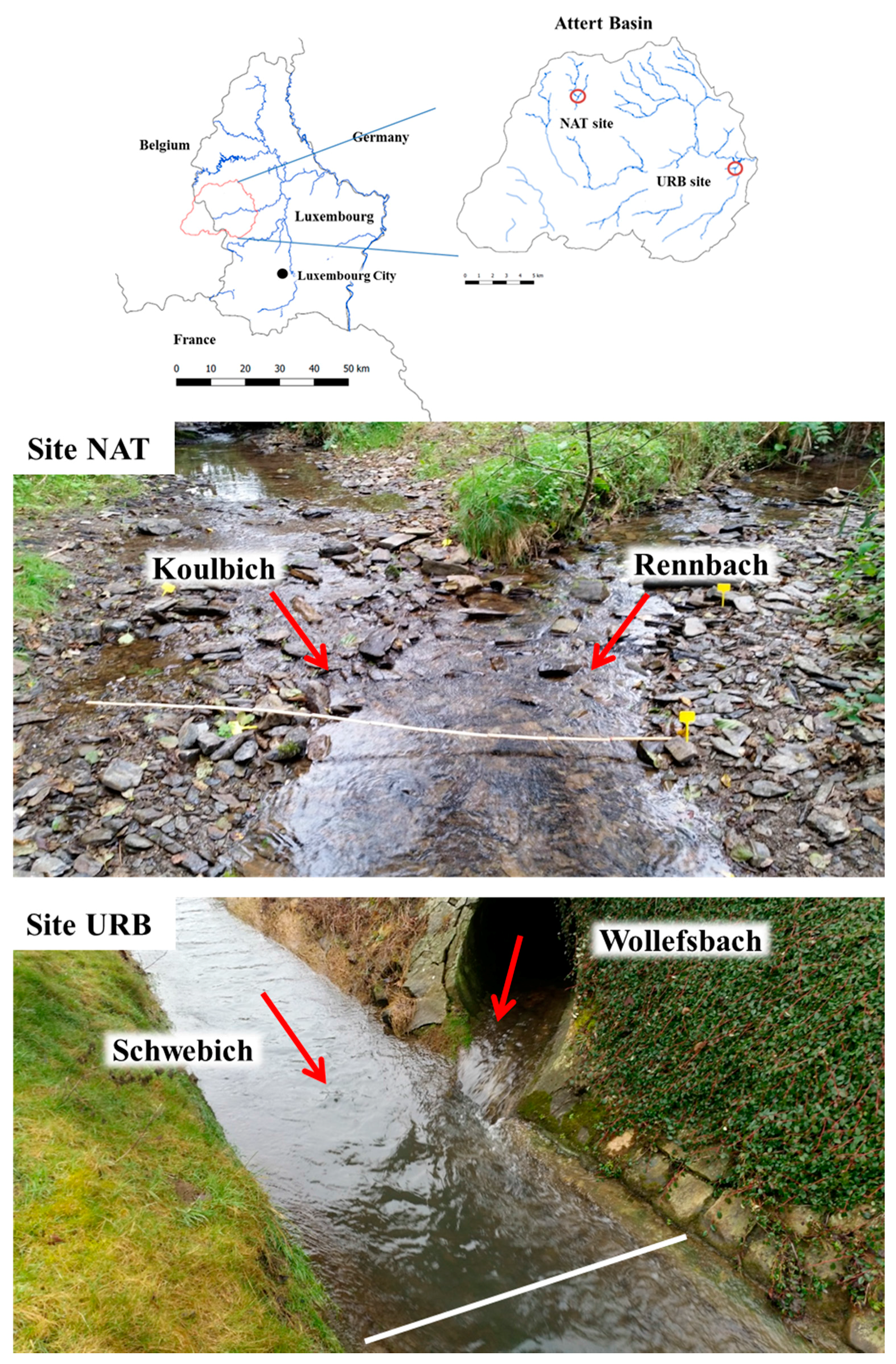
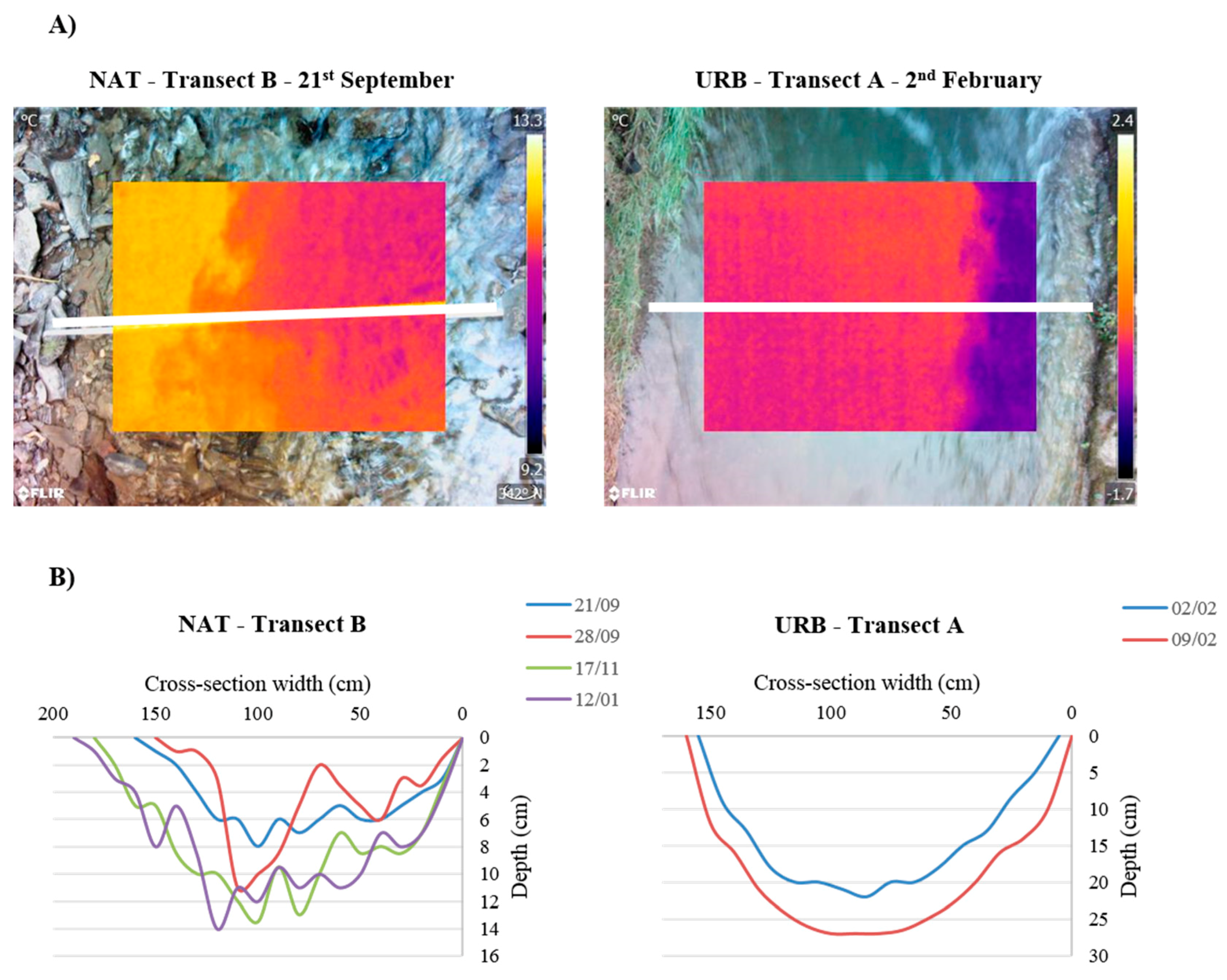
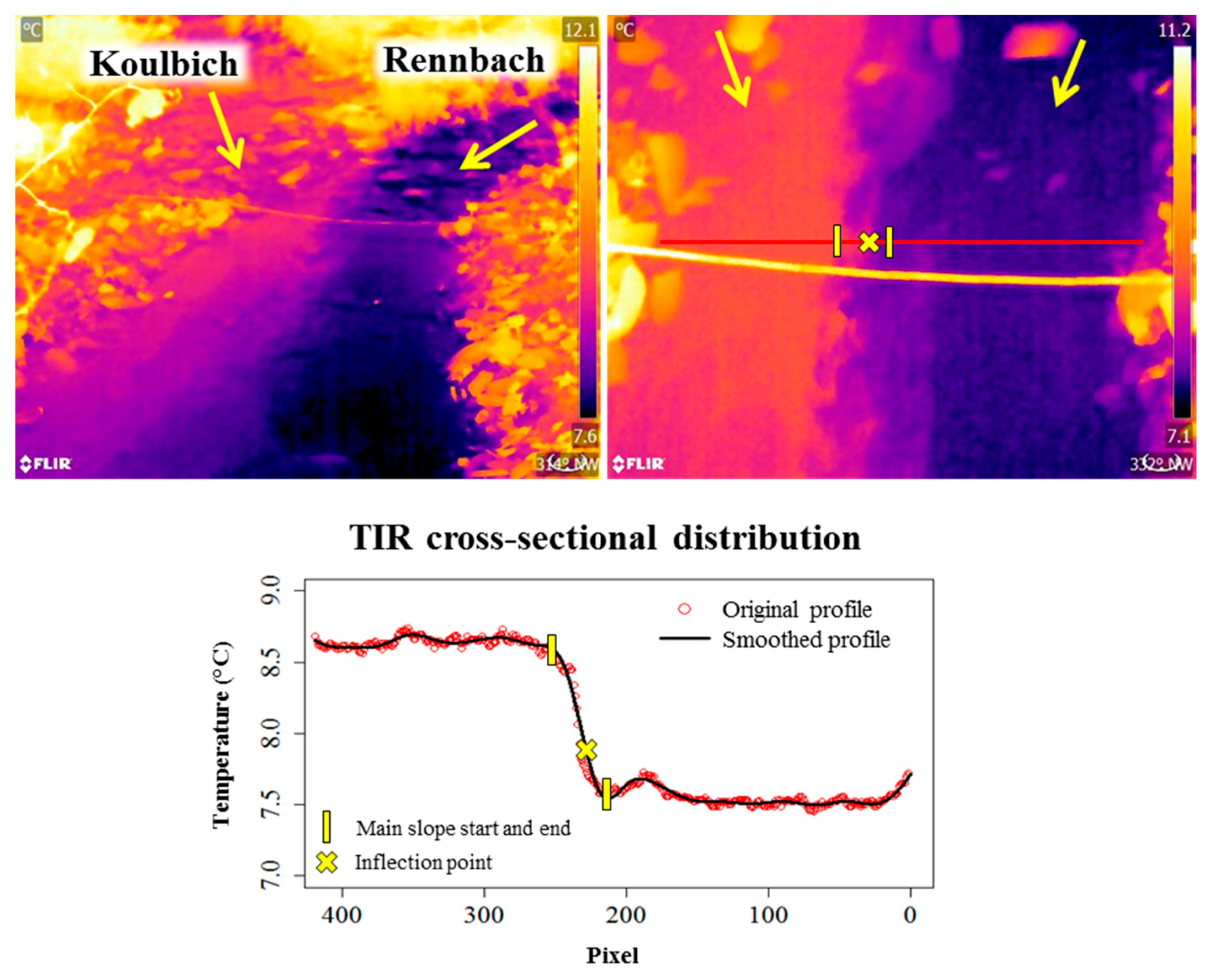
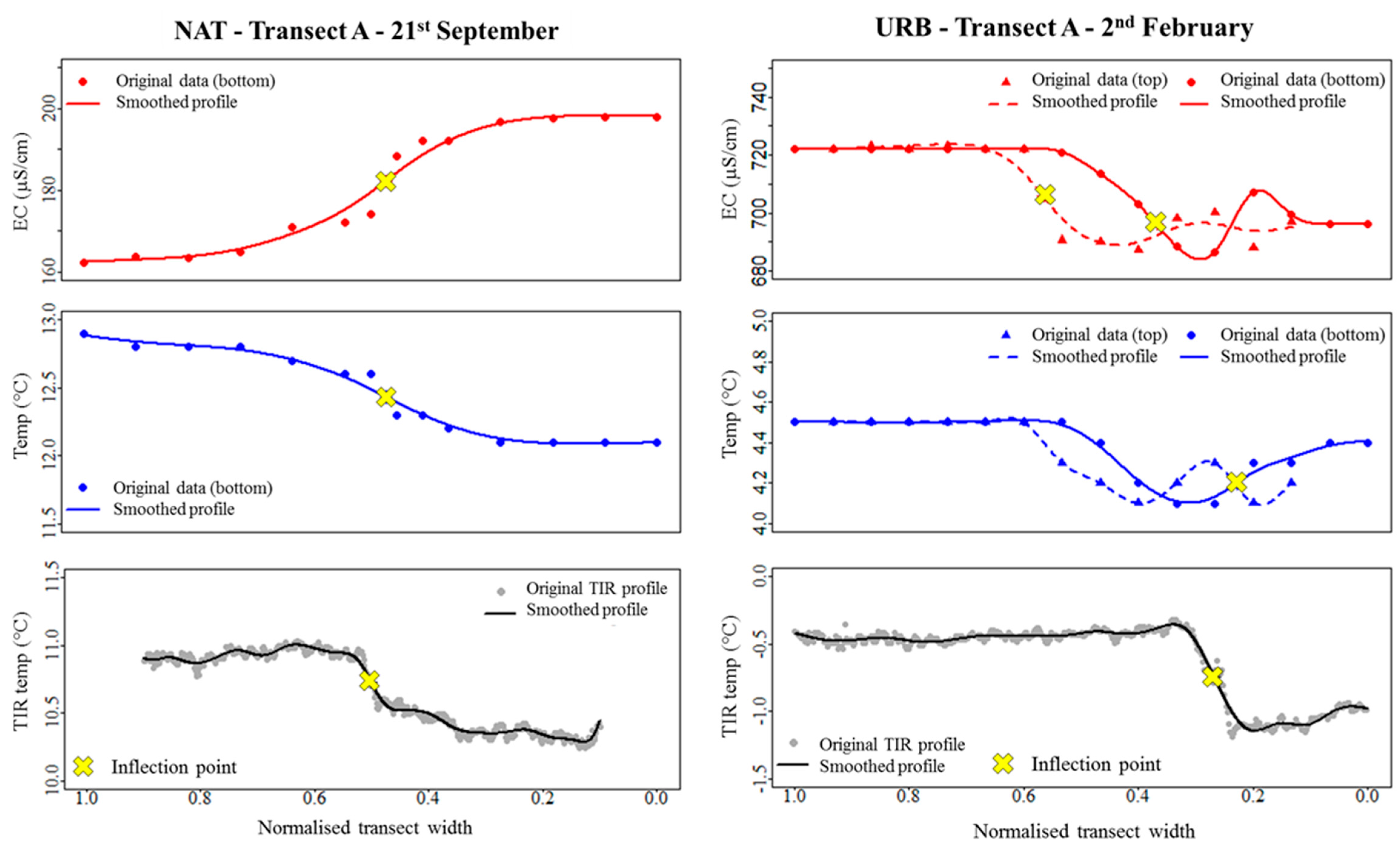

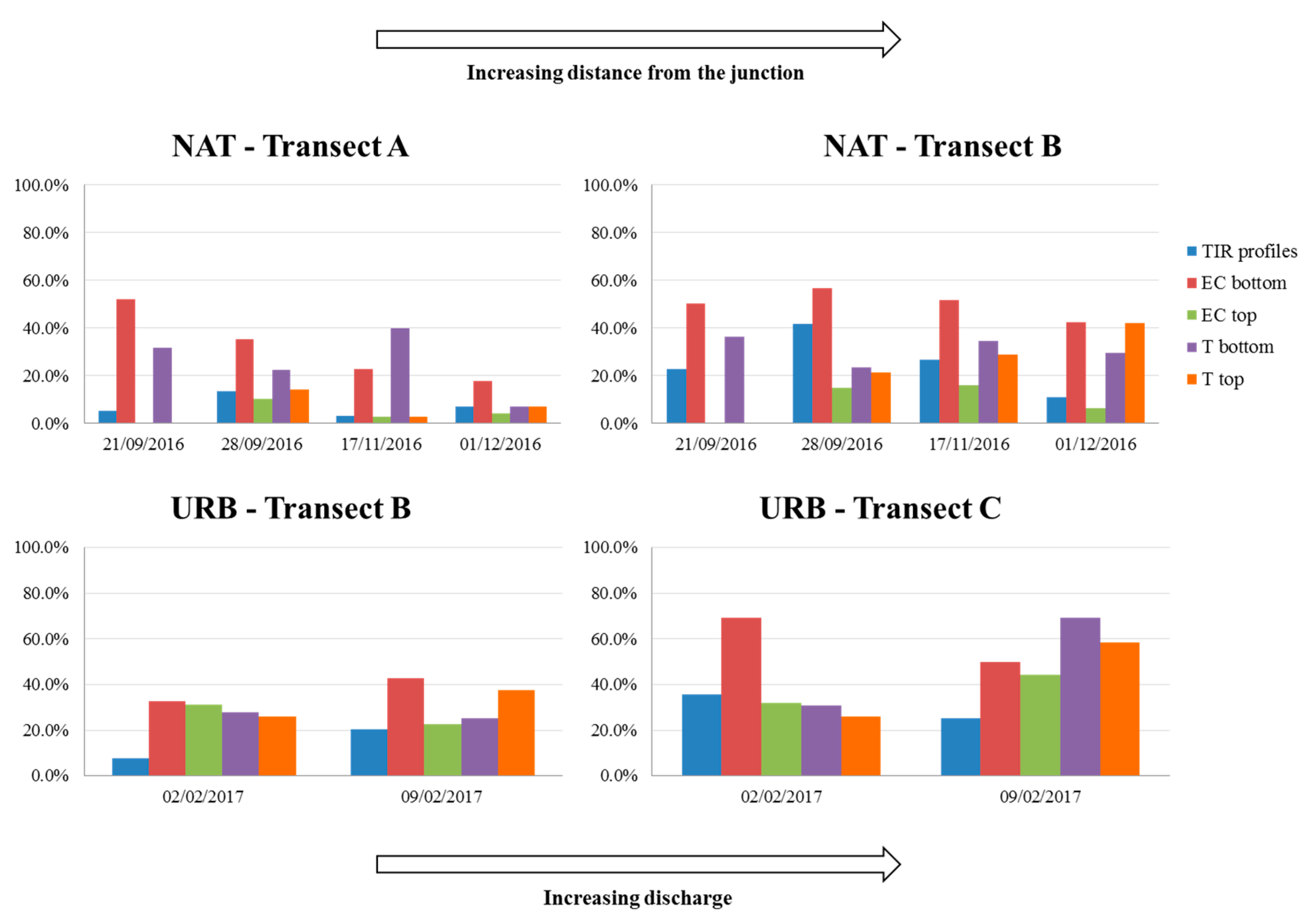
| NAT Site | URB Site | |||||||
|---|---|---|---|---|---|---|---|---|
| 21 September 2016 | 28 September 2016 | 17 November 2016 | 1 December 2016 | 2 February 2017 | 9 February 2017 | |||
| Air temperature (°C) | 13.9 | 13.7 | 7.9 | −0.4 | 5.2 | 0.6 | ||
| Discharge (L/s) | Rennbach | 4.7 | 2.8 | 19.0 | 17.73 | Schwebich | 131 | 203 |
| Koulbich | 3.6 | 2.6 | 13.2 | 15.96 | Wollefsbach | 30 | 42 | |
| Downstream | 8.5 | 5.0 | 31.0 | 29.4 | Downstream | 161 | 245 | |
| Distance to complete mixing (m) | 9.0 | 12.0 | 29.5 | 19.5 | 82 | 47 | ||
| Stream temperature (°C) at complete mixing | 13.1 | 11.5 | 7.6 | 2.1 | 4.9 | 4.5 | ||
| Δ Temperature tributaries (°C) | 0.8 | 1.3 | 0.3 | 0.3 | 1.0 | 0.5 | ||
| Δ EC tributaries (µS/s) | 35 | 32 | 65 | 55 | 97 | 65 | ||
| Sub-basin area (Km2) | Rennbach | 4.8 | Schwebich | 22.2 | ||||
| Koulbich | 4.9 | Wollefsbach | 4.4 | |||||
| Cross-section geometry | Semi-circular/highly irregular | Trapezoidal/semi-circular | ||||||
| Bed roughness | 0.03–0.05 * | 0.013–0.017 ** | ||||||
| Tracer velocity (m/s) | Rennbach | 0.07 | - | 0.14 | - | Schwebich | 0.22 | 0.34 |
| Koulbich | 0.19 | - | 0.08 | - | Wollefsbach | 0.24 | 0.46 | |
| NAT Site | URB Site | ||||||||
| A | A | ||||||||
| EC | Temp | EC | Temp | ||||||
| Bottom | Top | Bottom | Top | Bottom | Top | Bottom | Top | ||
| 21 September 2016 | 3 | 3.2 | 2 February 2017 | 15 | 44.7 | 5.9 | |||
| 28 September 2016 | 0.7 | 4 | 1 | 0.1 | 9 February 2017 | 59.9 | 63 | 99.2 | 24.5 |
| 17 November 2016 | 0.7 | 18 | 35.9 | 17 | |||||
| 1 December 2016 | 3.3 | 17.9 | 17.9 | 17.8 | |||||
| B | B | ||||||||
| EC | Temp | EC | Temp | ||||||
| Bottom | Top | Bottom | Top | Bottom | Top | Bottom | Top | ||
| 21 September 2016 | 6.8 | 4.9 | 2 February 2017 | 8.6 | 27.8 | 29.2 | 23.3 | ||
| 28 September 2016 | 21.8 | 30.4 | 24.5 | 33 | 9 February 2017 | 13.6 | 36.1 | 7.7 | 11.9 |
| 17 November 2016 | 32 | 33.4 | 30 | 28.9 | |||||
| 1 December 2016 | 7 | 6.3 | 4 | ||||||
| C | C | ||||||||
| EC | Temp | EC | Temp | ||||||
| Bottom | Top | Bottom | Top | Bottom | Top | Bottom | Top | ||
| 21 September 2016 | 43 | 29.3 | 2 February 2017 | 34.9 | 27.7 | 52.2 | 32.3 | ||
| 28 September 2016 | 8.8 | 12.8 | 9 February 2017 | 18.5 | 25.8 | 62.1 | 22.9 | ||
| 17 November 2016 | 49.3 | 64.1 | 64.1 | 36.5 | |||||
| 1 December 2016 | 8.8 | 1.6 | 22.5 | 15.8 | |||||
© 2017 by the authors. Licensee MDPI, Basel, Switzerland. This article is an open access article distributed under the terms and conditions of the Creative Commons Attribution (CC BY) license (http://creativecommons.org/licenses/by/4.0/).
Share and Cite
Antonelli, M.; Klaus, J.; Smettem, K.; Teuling, A.J.; Pfister, L. Exploring Streamwater Mixing Dynamics via Handheld Thermal Infrared Imagery. Water 2017, 9, 358. https://doi.org/10.3390/w9050358
Antonelli M, Klaus J, Smettem K, Teuling AJ, Pfister L. Exploring Streamwater Mixing Dynamics via Handheld Thermal Infrared Imagery. Water. 2017; 9(5):358. https://doi.org/10.3390/w9050358
Chicago/Turabian StyleAntonelli, Marta, Julian Klaus, Keith Smettem, Adriaan J. Teuling, and Laurent Pfister. 2017. "Exploring Streamwater Mixing Dynamics via Handheld Thermal Infrared Imagery" Water 9, no. 5: 358. https://doi.org/10.3390/w9050358
APA StyleAntonelli, M., Klaus, J., Smettem, K., Teuling, A. J., & Pfister, L. (2017). Exploring Streamwater Mixing Dynamics via Handheld Thermal Infrared Imagery. Water, 9(5), 358. https://doi.org/10.3390/w9050358







